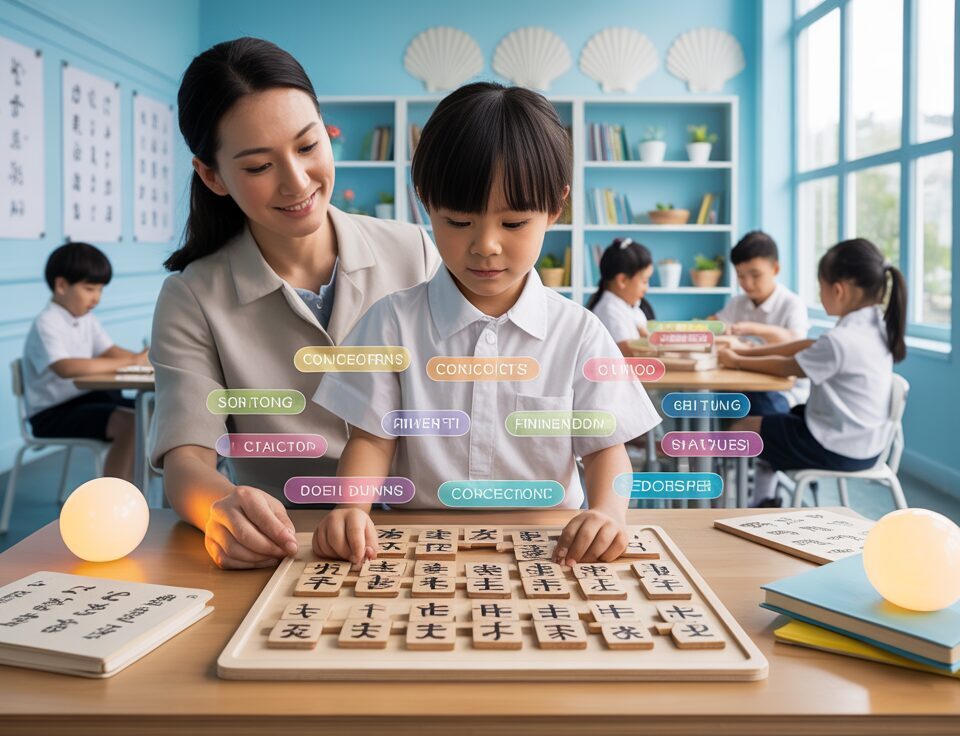
Master Chinese Oral Pronunciation: Essential Tone Drills & Recorder Guide
November 4, 2025
Essential Chinese Food & Dining Vocabulary: A Comprehensive Guide for Primary Students
November 8, 2025Table Of Contents
- Understanding Spaced Repetition: The Science Behind Effective Vocabulary Learning
- Benefits of Spaced Repetition for Primary School Chinese Students
- How to Implement Spaced Repetition for Chinese Vocabulary
- The Seashell Method: Integrating Spaced Repetition into Holistic Learning
- Common Challenges and Solutions
- Measuring Progress and Celebrating Success
- Conclusion: Building Sustainable Learning Habits
Learning Chinese vocabulary can feel like trying to memorize every grain of sand on a beach—overwhelming and seemingly endless. For primary school students in Singapore facing the challenges of mastering Chinese characters and vocabulary, the traditional approach of cramming before exams often leads to frustration, burnout, and poor long-term retention.
But what if there was a method that worked with your child’s natural memory processes instead of against them? A method scientifically proven to increase retention while actually reducing study time?
Spaced repetition is that method—a learning technique that transforms how students approach Chinese vocabulary acquisition, making it more efficient, effective, and enjoyable. At Seashell Academy by Suntown Education Centre, we’ve integrated this powerful approach into our unique Seashell Method, helping countless primary school students build strong foundations in Chinese language while fostering a genuine love for learning.
In this comprehensive guide, we’ll explore how spaced repetition works, why it’s particularly effective for learning Chinese vocabulary, and practical ways parents and students can implement this technique at home to complement classroom learning. Whether your child is preparing for PSLE Chinese or simply aiming to build confidence in their language skills, these strategies will help transform their learning journey.
Understanding Spaced Repetition: The Science Behind Effective Vocabulary Learning
Spaced repetition is not just another study technique—it’s a method grounded in cognitive science and memory research. First theorized by Hermann Ebbinghaus in the 1880s, this approach works with your brain’s natural memory processes rather than fighting against them.
The fundamental principle is simple yet powerful: review information at increasing intervals over time. Initially, you might review new Chinese characters within a day of first learning them, then three days later, then a week later, and eventually months apart. This strategic spacing prevents forgetting while minimizing study time—a winning combination for busy primary school students.
When applied to Chinese vocabulary learning, spaced repetition addresses one of the biggest challenges students face: the sheer volume of characters to memorize. Traditional methods often involve studying long lists of vocabulary repeatedly in a single session. While this might help students pass an immediate test, research shows that much of this information is forgotten within days.
Spaced repetition, by contrast, focuses on long-term retention by triggering what psychologists call the “spacing effect.” When we encounter information multiple times with gaps in between, our brains work harder to retrieve that information, ultimately strengthening the neural pathways that store those memories. This process is particularly valuable for learning Chinese characters, which require remembering multiple elements: the character’s form, pronunciation (pinyin), tone, and meaning.
Benefits of Spaced Repetition for Primary School Chinese Students
For primary school students studying Chinese, spaced repetition offers several distinct advantages that align perfectly with both learning objectives and developmental needs:
Reduced Overwhelm and Anxiety: Instead of facing hundreds of characters at once, spaced repetition breaks learning into manageable chunks, reducing the anxiety many students feel when confronting Chinese vocabulary. At Seashell Academy by Suntown Education Centre, we’ve observed that this reduced pressure often leads to greater confidence and willingness to engage with the language.
More Efficient Use of Study Time: Primary students have busy schedules with multiple subjects demanding attention. Spaced repetition optimizes study time by focusing on the vocabulary that needs review most urgently. This efficiency is especially valuable as students progress through primary levels, where the vocabulary requirements increase significantly between P4 and P6 Chinese preparation.
Better Long-Term Retention: Rather than learning for tests and then forgetting, spaced repetition builds vocabulary knowledge that lasts through PSLE and beyond. This cumulative knowledge makes each subsequent year of Chinese learning easier and more enjoyable.
Development of Learning Independence: As students become familiar with spaced repetition systems, they develop greater awareness of their own learning process. This metacognition is a valuable skill that extends beyond language learning to all academic subjects.
Reduced Frustration with Character Recognition: One of the most challenging aspects of learning Chinese is the moment when students encounter previously learned characters but cannot recall them. Spaced repetition dramatically reduces these frustrating experiences by maintaining recognition skills over time.
How to Implement Spaced Repetition for Chinese Vocabulary
Implementing spaced repetition doesn’t require complex systems or expensive resources. Here are practical approaches that work well for primary school students learning Chinese vocabulary:
Digital Tools and Apps
Technology offers some excellent solutions for implementing spaced repetition:
Flashcard Apps: Applications like Anki, Quizlet, and Pleco (specifically for Chinese) use algorithms to schedule reviews based on your child’s performance. These apps show characters more frequently when they’re new or challenging, and less frequently as they become familiar.
At Seashell Academy by Suntown Education Centre, we recommend parents help younger students (P1-P3) set up these systems initially, gradually transitioning to greater student independence in P4-P5 Chinese levels. For each new vocabulary list, create digital flashcards with:
– The Chinese character on one side
– The pinyin, tone, and meaning on the other side
– For complex characters, consider adding a memory hook or decomposition of the character parts
Chinese Learning Platforms: Specialized platforms like DuChinese and HelloChinese incorporate spaced repetition within a broader learning environment. These can be particularly engaging for primary students as they often include game elements and visual rewards.
Physical Methods and Techniques
Not all spaced repetition systems need to be digital. Physical methods can be especially effective for kinesthetic learners and younger students:
The Box System: This classic approach uses five boxes or envelopes labeled with different review intervals:
Box 1: Daily review
Box 2: Every 3 days
Box 3: Weekly review
Box 4: Bi-weekly review
Box 5: Monthly review
Start by placing all new vocabulary cards in Box 1. During each study session, review cards from Box 1. If your child knows a card well, move it to Box 2. If they struggle, it stays in Box 1. Apply the same process to each box, advancing cards as they become familiar.
Vocabulary Calendar: For a visual approach that works well with family involvement, create a review calendar. Write new Chinese characters on sticky notes and place them on dates in the calendar following the spaced repetition principle—first review after 1 day, then 3 days, then a week, etc.
Character Connection Journals: In our P4 Chinese program, we encourage students to keep a journal where they record new vocabulary along with personal connections or stories related to each character. During review sessions, these connections make retrieval more meaningful and effective.
Parent-Guided Spaced Repetition Approach
Parents play a crucial role in implementing spaced repetition, especially for younger primary students. Here’s a structured approach for parents who want to support their children’s Chinese vocabulary learning:
Step 1: Establish a Consistent Schedule – Set aside 15-20 minutes, 3-4 times per week, for vocabulary review. Consistency is more important than duration.
Step 2: Prioritize Vocabulary – Work with your child’s Chinese teacher to identify the most important vocabulary to focus on. At Seashell Academy by Suntown Education Centre, we provide parents with prioritized vocabulary lists that align with our curriculum and the MOE syllabus.
Step 3: Create Review Materials – Whether digital or physical, prepare the review materials with your child. The process of creating flashcards itself is an effective learning activity.
Step 4: Implement the Spaced Schedule – Follow a schedule that gradually increases intervals between reviews:
– First review: Same day as learning
– Second review: 1 day after learning
– Third review: 3 days after learning
– Fourth review: 1 week after learning
– Fifth review: 2 weeks after learning
– Final reviews: Monthly until consistently recalled
Step 5: Make It Interactive – Transform review sessions into games or challenges. For example, time how quickly your child can correctly identify 10 characters, trying to beat previous records.
The Seashell Method: Integrating Spaced Repetition into Holistic Learning
At Seashell Academy by Suntown Education Centre, we’ve integrated spaced repetition into our broader Programme Philosophy through what we call the Seashell Method. This approach recognizes that effective learning isn’t just about memory techniques—it’s about building connections between vocabulary and real-world application.
Our method combines spaced repetition with:
Mind-Mapping for Vocabulary Networks: Rather than learning words in isolation, we teach students to create semantic networks that connect related vocabulary. This approach strengthens recall by creating multiple retrieval paths in memory.
For example, when learning food vocabulary, we create a mind map connecting different categories (fruits, vegetables, dishes) with their associated words. During spaced repetition reviews, we sometimes prompt with categories rather than individual words, strengthening these semantic connections.
Contextual Learning: We embed vocabulary in meaningful contexts through stories, conversations, and practical scenarios. During review sessions, we don’t just ask for the meaning of isolated characters—we ask students to use them in sentences or identify them in reading passages.
Emotional Engagement: Research shows that information with emotional connections is better remembered. We encourage students to associate Chinese vocabulary with personal experiences or create imaginative stories involving the characters.
Gamified Interactive Elements: Our spaced repetition activities incorporate game elements that make review sessions engaging rather than tedious. Competition, challenges, and rewards maintain motivation throughout the learning process.
Common Challenges and Solutions
While spaced repetition is highly effective, implementing it consistently can present challenges. Here are solutions to common obstacles faced by primary school students and their parents:
Challenge: Maintaining Consistency
Solution: Start with a modest schedule—perhaps just 10 minutes, three times a week. Set specific times for review sessions and link them to existing routines (e.g., right after dinner). Use visual trackers to celebrate consecutive days of practice, building a streak that children become motivated to maintain.
Challenge: Review Sessions Becoming Boring
Solution: Vary the format of your review sessions. Alternate between digital apps, physical cards, games, and contextual use. At Seashell Academy by Suntown Education Centre, we teach students multiple review formats and encourage them to choose the one that feels most engaging on any given day.
Challenge: Difficulty with Complex Characters
Solution: For particularly challenging characters, incorporate mnemonic techniques alongside spaced repetition. Break characters down into component parts, create stories about the character components, or relate the character to a similar-looking object. These memory hooks make the spaced repetition process more effective for complex vocabulary.
Challenge: Balancing School Workload
Solution: Integrate spaced repetition into homework time rather than treating it as an additional task. Five minutes of focused review often yields better results than longer, less frequent sessions. For P6 Chinese students preparing for PSLE, we recommend aligning spaced repetition schedules with the examination timeline, gradually increasing review frequency for essential vocabulary as the examination approaches.
Measuring Progress and Celebrating Success
Effective implementation of spaced repetition includes tracking progress and recognizing achievements. Here are strategies we recommend at Seashell Academy by Suntown Education Centre:
Vocabulary Benchmarks: Set clear goals for vocabulary acquisition. For example, mastery of 50 new characters per month, with “mastery” defined as correct recall across multiple review sessions.
Recognition vs. Production: Track both passive recognition (can identify when seen) and active production (can write from memory) separately. Recognition typically develops faster and can be celebrated as an important milestone on the way to full mastery.
Application Metrics: Measure how well students can use vocabulary in context, not just recognize isolated characters. Can they use the words in sentences? Identify them in reading passages? These application skills demonstrate deeper learning.
Visual Progress Trackers: Create visual representations of progress—charts, graphs, or even physical displays where students add elements (like colored stones in a jar) as they master new vocabulary sets.
Celebration Rituals: Establish special celebrations for significant milestones. These don’t need to be elaborate or expensive—even a special certificate or a choice of weekend activity can serve as meaningful recognition of achievement.
Remember that progress in language learning isn’t always linear. There will be plateaus and even temporary setbacks. At Seashell Academy by Suntown Education Centre, we emphasize that these are normal parts of the learning journey and opportunities to adjust strategies rather than reasons for discouragement.
Conclusion: Building Sustainable Learning Habits
Spaced repetition is more than just a technique for memorizing Chinese vocabulary—it’s a framework for developing sustainable learning habits that serve students throughout their educational journey. By working with the natural rhythms of memory rather than against them, this approach transforms vocabulary acquisition from a source of stress into a manageable, even enjoyable process.
For primary school students navigating the challenges of Chinese language learning, spaced repetition offers a path to success that emphasizes steady progress over cramming, understanding over rote memorization, and long-term retention over quick fixes.
At Seashell Academy by Suntown Education Centre, we’ve witnessed the transformation that occurs when students adopt these principles. Not only do they perform better in assessments and examinations, but they also develop greater confidence in their ability to master challenging material. Perhaps most importantly, many discover a genuine appreciation for the Chinese language that extends far beyond the classroom.
As parents and educators, our goal isn’t just to help students pass tests—it’s to nurture a love of learning and provide tools that serve them throughout life. Spaced repetition, especially when integrated into a holistic approach like our Seashell Method, helps achieve this broader educational mission.
Whether your child is just beginning their Chinese language journey in P1 or preparing for PSLE in P6 Chinese, incorporating spaced repetition into their study routine can make a significant difference in both results and experience. Like the gradual formation of a pearl within a seashell, language proficiency develops layer by layer, with each review session adding new strength and luster to their knowledge.
Mastering Chinese vocabulary doesn’t have to be a daunting challenge. With the science-backed approach of spaced repetition, primary school students can build strong vocabulary foundations in a way that’s efficient, effective, and sustainable.
By implementing the strategies outlined in this guide—whether through digital tools, physical methods, or a combination of approaches—students can transform their relationship with Chinese language learning. The key is consistency, patience, and trust in the process.
At Seashell Academy by Suntown Education Centre, we integrate these principles into our comprehensive Chinese language programs, supporting students at every stage of their primary school journey. We believe that every child can develop not just proficiency in Chinese vocabulary, but genuine confidence and enjoyment in using the language.
The journey of language learning, like the formation of a pearl in a seashell, takes time. But with the right approach—one that works with your child’s natural learning processes rather than against them—the results can be truly beautiful.
Ready to Transform Your Child’s Chinese Learning Journey?
At Seashell Academy by Suntown Education Centre, we help primary school students build strong foundations in Chinese through our unique Seashell Method, which includes spaced repetition techniques tailored to each child’s learning style.
Our experienced MOE-trained educators provide personalized guidance in small classes, ensuring your child receives the attention they need to thrive.
Contact us today to learn more about our P4 Chinese, P5 Chinese, and P6 Chinese programs, or to schedule a consultation.





